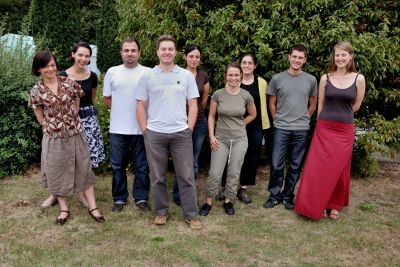
Agroecology Reading time 6 min
Olivier Loudet, évolution and adaptation in plants
Published on 22 September 2009
The Man who meditated on the shape of plants ...
Olivier Loudet has long been fascinated by evolution and adaptation in plants. Those two words also guide his approach to science. "When I hiked in the mountains," he recounted, "I observed plants, their pliability, the way a pine tree can shape itself under the force of the wind. To adapt, plants use an array of forms and functions that is much more vast than the range available to animals. The things that separate a cactus from a plant like Arabidopsis thaliana are, to me, more spectacular than the differences between a mammal and an amphibian." While studying engineering at the school of agronomy in Rennes, Loudet quickly focussed on plants, initially in applied studies when he did an internship on disease resistance in wheat under the supervision of plant breeders. "The experience taught me to observe plants in the field. I was awestruck by the unerring eye of these professionals who, in the midst of thousands of plants, could pick out the ones that were most likely to grown in specific conditions. Since that time I look at my plants every day!" Olivier Loudet then did his DEA (currently known as Master 2) internship at INRA-Lusignan on variable root system development in maize in response to the light exposure of the plant's aerial parts. "I understood then that scientific questions were relevant not only in applied settings, but in and of themselves, from a biological viewpoint, even in cultivated species." When he worked on his doctoral thesis at INRA-Versailles and his post-doctorate at the Salk Institute of San Diego, he turned his attention to the model species Arabidopsis thaliana to study the workings of natural variability in a wild species. "It was fairly visionary at that time to devote energy to quantitative genetics for a model species. Plenty of scientists either said that it would be enough to study mutants to understand the variability of the species, or that our plant model wasn't interesting from an ecological and evolutionary point of view." He joined INRA in 2004 and continued working on the same wild species.
... and tracks the Arabette
Oliver Loudet does not equate working on the model species with staying inside a lab. As a field researcher, he travels the world, bringing back Arabidopsis specimens from areas as different as the mountains of Kyrgyzstan, the plains of Iran, and the volcanoes of Sicily. Back in the laboratory, he attempts to identify the genetic variations that account for these adaptations. His work has recently led to two major results.
The first established the importance of randomness and "neutrality" in the evolutionary process, adding a nuance to the generally accepted notion that all characteristics observed in nature were selected because they conferred an adaptive advantage. For some ten genes studied in 600 specimens from different sources, certain seemingly-positive variations do not spread, while others of little impact are maintained. An individual's characteristics do not, therefore, systematically come from an active and coordinated selection process.
Genes can move, duplicate or disappear
The second major breakthrough of Loudet's team was to show the importance of genome structural variations in variability. Genes can move, duplicate, change their location in a chromosome or even move to different ones, or disappear. The researchers demonstrated in a sample that when this happens to an essential gene, it can produce individuals that may have difficulty cross-breeding because the functional gene is missing in some of the offspring. These individuals could, little by little, become incompatible and end up forming two different species.
Olivier Loudet's work thus sheds light on some basic mechanisms in the evolutionary and adaptive processes of plants. Such processes could be harnessed to improve cultivated species that come up against similar constraints. Loudet sometimes observes unexpected characteristics during his daily inspections of plants grown in different milieus. "We work mostly on adaptation to drought and cold," he said, "but that doesn't mean we don't observe other variations. We adjust to what the plants show us. For instance, we've found a gene that was expressed in response to mannitol, a substance used to trigger a form of water stress in plants. The gene doesn't respond to water stress per se but is more involved in sugar metabolism, which is disturbed by mannitol. It's not up to us to decide which gene or variability mechanism we're going to identify." He explained that this lack of preconceptions helps keep his lab going. When a lead turns into results – meaning publication in a major journal – this generates funding, and, along with the money, promising students who work on projects that were on the back burner and are thus given a chance to stand out.
"One of the major advantages of publicly-funded research in general, and INRA in particular," he concluded, "is that we can follow leads simply because they're interesting, even if they don't match what we were initially looking for."
Accolades rarely come unaccompanied. The European Research Council, on the lone criterion of excellence, has just awarded one of 250 grants to support EU-level frontier research to Olivier Loudet – a boon to his research team, giving them funding for the next five years as they work on "decoding the complexity of quantitative natural variation in Arabidopsis thaliana."

- 35 years old
- 2 children
- Degree in engineering from the School of Agronomy of Rennes (AgroCampus Rennes)
- Master 2 degree from the University of Rennes
- PhD from INA-PG (Agro-ParisTech)
- Leisure activities: mountaineering, diving, travel
Distinction
- 2009 Laureate of the "Starting Independent Researcher Grant" of the European Research Council
